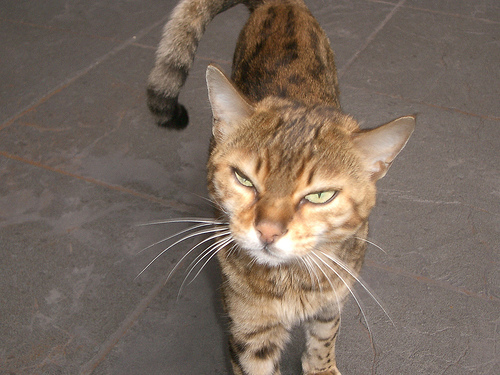Reader…
Just stumbled on this post… Interesting stuff.
I know lots of folks who kiss their cats (including myself). Now there’s a revelation. This article does make you think about cat handling issues. I’m sure (from my own experience) that it’s mainly the young and elderly who are most at risk….here’s the short article.
I’d be interested to hear any ‘tales’ you might have of cat ailments you’ve caught? Cat scratch fever!…I’ve not caught it yet, touch wood.
~~~
~~~
Steps to Prevent Disease Transmission from Cats to Man
- 1. Wear gloves when handling cats, or their body products such as: urine, feces, blood, nasal discharges, fluids draining from wounds. After removing your gloves, wash your hands with soap and water.
- 2. Never eat, drink or smoke in areas where cats, their wastes, or body products are being handled. Absolutely no eating, drinking or smoking is allowed where cats are housed.
- 3. Report all suspected sick cats as soon as possible so that a veterinarian may determine the cause of the illness and implement any additional protective steps.
- 4. Although a normal, healthy adult person may have only mild symptoms of a particular zoonotic disease, that person may spread the disease to others. Cases of animal handlers “carrying home” zoonotic diseases to their infants, with fatal consequences have occurred. Therefore, good hygiene is not only to protect the person working directly with cats, but all persons with whom they have contact.
At special risk are persons who may have a suppressed immune system, such as: infants, the elderly, people who have had their spleens removed, and people with long-term or debilitating conditions such as cancer, diabetes, AIDS and renal failure.
The list of possible zoonotic diseases is extensive and this module only attempts to highlight a few which are more commonly found.
ALLERGIC SENSITIVITIES Allergic skin and respiratory reactions are quite common in personnel working with cats and other animals. Consult your physician. Wear protective clothing to prevent direct contact with cats, waste, carcasses and other body products.
CAT SCRATCH FEVER caused by Bartanella henselae causes regional lymphadenitis usually associated with a history of a scratch or bite by a cat. Cat-scratch disease is usually self-limited; however in the presence of the HIV, causes severe disease.
RABIES This virus is transmitted by infected saliva, usually by a bite wound, but viral laden saliva may enter preexisting wounds or abrasions. The virus travels up a nerve to the spinal cord and finally reaches the brain. After a variable incubation period, rabid animals or humans will exhibit signs related to central nervous system (CNS) disfunction, and once this occurs, death is inevitable! For this reason, persons bitten by cats should always see a physician and discuss the correct course of treatment. Most animal caretakers will choose to take a series of pre-exposure vaccinations, which will facilitate treatment should they ever be bitten by an infected cat. Cats may be infected by exposure to infected bats.
RINGWORM caused by Microsporum canis is a highly contagious fungal disease. It occurs most often in temperate and tropical climates. People become infected by touching a contagious cat and then failing to wash their hands. When a cat is confirmed positive people should wear protective clothing such as a gown and gloves. Asymptomatic animals may also contaminate and infect susceptible people.
TOXOPLASMOSIS caused by Toxoplasma gondii. Clinical infections are relatively uncommon, but extremely hazardous. The method of exposure is through the feces, therefore wearing gloves when cleaning litter boxes is very important.
Despite all this, I know I for one wouldn’t be without my moggy!
Ed.






















